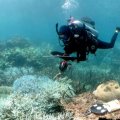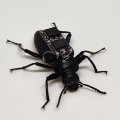Lush conifer forests interspersed with flowering trees and herbs bordering a vast inland sea - it may be hard to imagine but this was the scene around Winton in western Queensland 95 million years ago.
Using beautifully-preserved ancient plant tissue trapped in sediment, University of Queensland Botany Department researchers are piecing together Australia's botanical landscape from the Late Cretaceous and earliest Tertiary period (60-95 million years ago).
The study is believed to be the most comprehensive investigation ever conducted on the evolution of Australia's native flora, especially angiosperms (flowering plants). It furthers general understanding of angiosperms which appeared world-wide some 15 million years earlier.
Funded by a three-year, $144,000 Australian Research Council Large Grant, the project is jointly led by Botany Department Head Professor George Stewart, Dr Mary Dettmann and Dr Mike Pole.
The ancient spores, pollen, leaf and cuticle samples include some of the world's most exquisitely preserved plant matter - real tissue preserved in sediment as opposed to impressions left in rock - derived from western Queensland core samples.
Samples are so detailed they include fossilised fungi attached to individual leaves.
Most plants would have formed part of the diet of the herbivorous dinosaurs which roamed the continent, Dr Dettmann said. She said the core samples under examination came from the same area as the famous dinosaur stampede tracks at Winton.
'The project aims to reconstruct plant communities existing in Australia during the period and identify changing vegetational and environmental patterns through time and space using taxonomic and stable carbon isotope signals from fossilised spores, pollens, leaves, cuticles and other plant tissue,' Professor Stewart said.
Dr Pole said vegetation of the time would have consisted mainly of diverse conifer (pines) and ginkgos (the maidenhair tree) dotted with early flowering plants (herbs and trees).
'Marine fossils such as shellfish at the base of core samples suggest inland Australia was the site of a vast sea, gradually retreating and being replaced by a lake and river system,' Dr Pole said.
'Coal present in some of the drill cores suggests extensive swamps and therefore a wet environment.'
Ancient plant material, separated from other particles within the core samples using boiling water and acid, appears as a black compost which is studied using electron or light microscopes.
Professor Stewart uses mass spectrometry techniques to extract and study isotopes, in particular carbon 13, embedded in the cuticle or skin of ancient leaves.
'Isotope data provides information about the period's environmental conditions such as climate and atmospheric carbon dioxide content. So far, I have established these ancient cuticles contained much higher amounts of carbon 13 than plant cuticles today,' he said.
'I have also found that the type of photosynthesis used by the ancient flowering plants was very similar to that used by their descendants today, suggesting a lush environment with a good water supply.'
Dr Dettmann's research is concerned with ancient pollens while Dr Pole is studying the structure of ancient leaf cuticles, including their pores or stomata. As with pollens, stomata help identify the types of plants which existed at the time.
'The number and placement of cells around stomata are used to identify different species today. Interestingly, with the ancient angiosperms, there is often no consistency in cell numbers arranged around stomata - some have two, others many. This suggests the early angiosperms were throwing out many different plant styles to let evolution take its course and select the best form for survival,' Dr Pole said.
Dr Pole said relatives of the ancient plants existed today with some versions not drastically different from their ancestors, for example, the flame tree.
The Queensland Geological Survey provided the many core samples required for the study.
For more information, contact Professor Stewart (telephone 3365 2727), Dr Dettmann (telephone 3365 2744) or Dr Pole (telephone 3365 1745).
.jpg)


